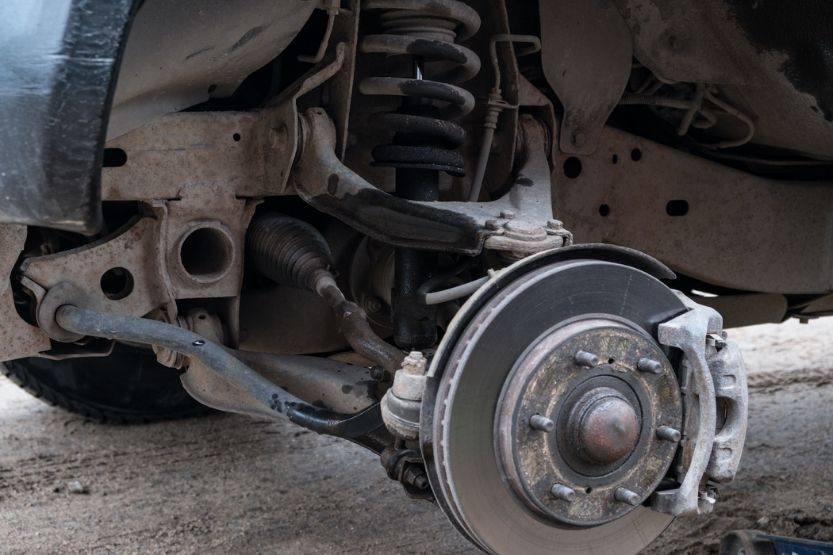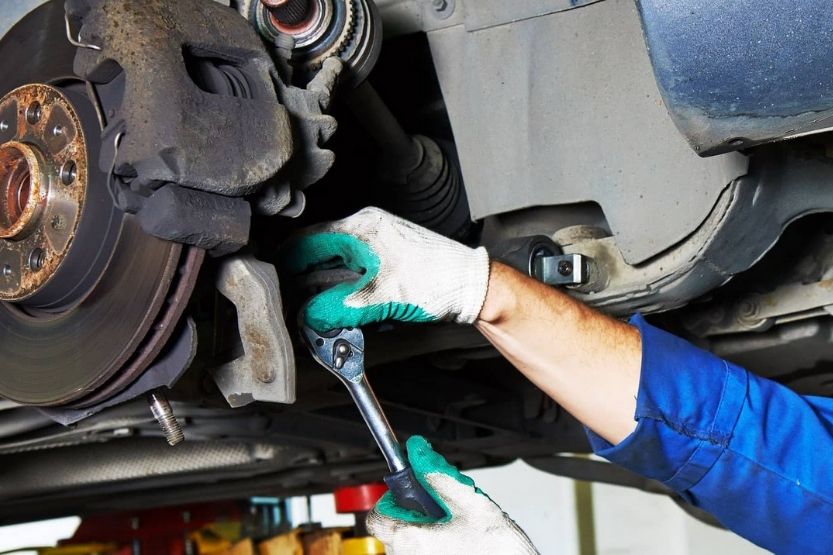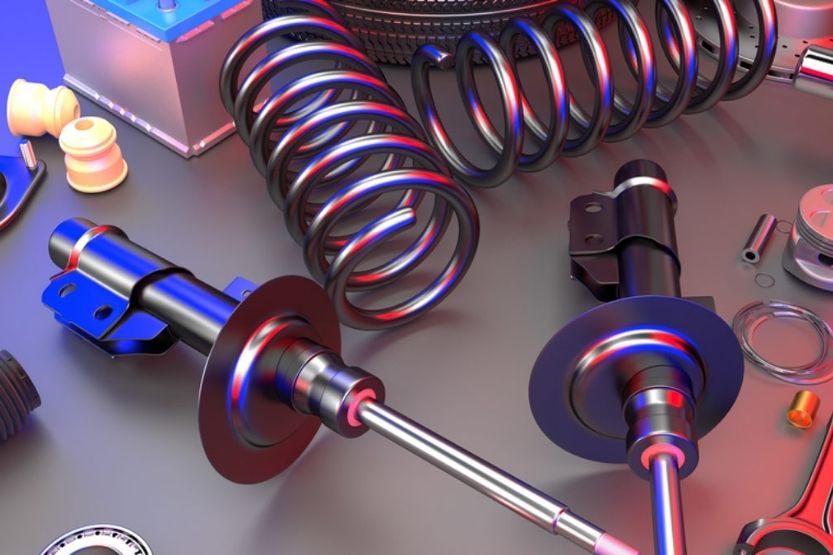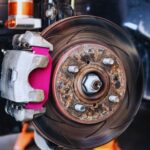Your car’s struts are an essential part of the vehicle’s suspension system. Struts are mounted above the chassis at the front-end for most front-wheel-drive cars. Their function is to reinforce and support the vehicle’s weight while absorbing impact so that you’ll have a smooth ride. Unfortunately, struts, like all car parts, get worn out. How long does it take to replace front struts?
It takes about two to three hours to replace shocks and struts. The time to get the struts replaced depends on the skill level of who is replacing them and how rusted the bolts are.
Replacing your struts has become easier nowadays with the availability of complete strut assembly kits in the market. You can purchase a kit and replace your struts in about 2 hours by yourself.
Read on to find out more about how long it takes to replace struts, how to replace struts yourself, and tips on strut replacement.
Also, take a look at front strut replacement kits on Amazon to see if there is a kit for your specific vehicle model, for example:
Click here to see it on Amazon.
How Long Does It Take to Replace Front Struts?

It takes about 2 to 3 hours to replace struts. The time to get the struts replaced depends on the skill level of who is replacing them and how rusted the bolts and joints are.
When you have worn-out struts, you have to replace them because they can cause more damage. Worn-out struts can hurt your tires with the uneven bouncing it can cause. It’s also not wise to drive with worn-out struts because your stopping distance increases by 10 feet. Struts can be expensive to replace, but it’s a job that needs to be done.
There are available assembly kits in the market for strut replacement. These assembly kits allow you to change your front struts in less than two hours. For example:
Click here to see it on Amazon.
Before the arrival of these assembly kits, I do not recommend replacing your vehicle’s strut on your own. It was a dangerous thing to do because it would require compressing the spring and removing the strut, and if they pop, it can damage anything in the way, including yourself.
The assembly kits make replacing struts easy and can save you a few hundred dollars. Of course, you’ll need a wheel alignment after replacing your struts, which will cost about $100.
Signs That My Car Needs New Struts
Your struts are a vital part of your vehicle’s suspension system. They lessen the springing action of your car, stopping the bounce. This way, you can prevent damage to your car’s underside. Meaning you can steer easily. Moreover, you get properly aligned wheels, too, giving you a comfortable ride.
There are signs that your car needs new struts. Don’t ignore these signs, as driving with worn-out struts can cause more damage to your vehicle. Let’s look at the signs that you need to replace your front struts:
1. It’s a Bumpy Ride
Having a bumpy ride is the first sign that you need to replace your vehicle’s strut. It’s going to be an uncomfortable ride with more bumps and bounces. You’ll feel it even more if you drive over a pothole or a bump, and you feel like you can’t control your car. Have your struts checked right away when this happens.
2. Difficulty with Steering
This is another huge sign that you need to replace your struts. You’re going to feel that your steering wheel is hard to turn. Your car will also tend to veer or sway upon making turns or when you change lanes.
3. Problems with Your Brakes
You may feel that your car is unstable or lurches forward when you hit your brakes. Check your struts when this happens, along with the other signs of worn put struts.
4. Uneven Wearing Out of Tire Treads
You’ll notice uneven wearing out of your tire treads because your wheel alignment isn’t correct. This will be noticeably different from the usual wearing out of tires because of aging. You’ll have badly cupped tires, and this is a dangerous problem, so have your vehicle checked immediately.
5. Fluid Leaks
Inside your struts, there is hydraulic fluid. If there’s a leak from your struts, then
It’s a visual clue that your struts are worn out when you notice that there’s a leak coming from that part of your car.
6. Mileage
Your car’s manual will have a recommendation of when to have your struts replaced. Usually, it’s at 50,000 miles. Check your manual and follow the recommendation.
How to Change Your Front Struts

When you go beyond 50,000 mileage, check your vehicle’s strut. Strut replacement can be expensive. However, you can save a lot of money by changing your front struts yourself. As mentioned earlier, it will take you about 2 to 3 hours to replace front struts – if you know what you are doing. It isn’t too difficult to replace them yourself.
Below are 9 steps to replace the front struts on your car or truck:
1. Locate Your Struts
You won’t know what to change if you can’t identify it. Your struts are metallic cone-shaped parts that have a spring around them. They’re pistons that are filled with hydraulic fluid. Inside your hood, you’ll find the bolts for the struts. These are three bolts on a pan located in the engine compartment on either side of the car.
2. Remove the Wheel
Use a lug wrench to loosen the bolts that secure your wheel and then lift the car with a jack. When the car is lifted, place a jack stand under the car. Completely loosen and remove the wheel bolts and then remove your wheel.
3. Remove the Bolts from the Steering Knuckle
Holding your struts to the steering knuckle, you’ll see two or three bolts. Often, these bolts may be rusted and difficult to take out. What you can do is spray WD-40 on them to help loosen them. Remove the bolts by removing the nuts and loosen the struts.
4. Remove the Bolts in the Strut Towers
Open your hood and locate your strut towers. They are cylindrical in shape and are held by three bolts. Remove the strut tower bolts. LEAVE THE CENTER NUT, or else the strut will fall. Your strut is under high spring tension. The springs need to be compressed first.
Tip: Have someone hold the strut assembly while you’re loosening the bolts just in case the strut falls.
5. Pull Out the Old Strut
If you’re going to compress your springs, DO NOT unscrew the center bolt in your strut tower until you’ve compressed your springs. However, if you’re going to change your struts with a strut assembly, you can eliminate the old struts and install the new struts.
If you’re a beginner and this is the first time you’re changing struts, don’t try to compress the springs of your old struts. Some experienced people do this to save money by re-using the old springs on their new struts. But, for a few hundred dollars more, you can get a whole new strut assembly kit that is pre-assembled, making it easier to install.
6. Compress the Spring (This Step Is Only for Re-using Springs)
If you’re installing a quick, pre-assembled strut kit, skip this step and continue with strut installation.
Before you compress your springs, make certain that the compressor is pointed away from things and persons it may damage. If you have no experience with this, have your springs compressed by someone who has done it before.
Remove the center nut. This nut looks like a disc. You’ll need to remember the strut top plate removal when you take it off so that you can put it back in the same position. Remove your strut from the spring while the spring is still compressed.
WARNING: Do not use a spring compressor if you do not have proper instructions or help. Compressed springs have stored energy and, when decompressed, can damage anything in its path. A quick-strut assembly is the best option if you want to change your struts for the first time.
7. Install the New Struts
Put back your bolts, screwing them on not too tight so that the assembly can still move freely. Next, install your strut assembly into the strut tower. Put the strut tower bolts back in place. Tighten the bolts now with a wrench. Torque according to what the manufacturer specified.
8. Replace the Wheel
Put back the lug bolts and then lower your car—jack up your car a little so that the load on the jack stands is eased a little. Remove the jack stands and lower the car. Tighten the wheel and your strut tower bolts.
9. Check to See That Everything Is In Place
The best thing to do to test that you properly replaced your struts is to test drive your vehicle. Drive at low speed in low-traffic areas. If the car veers towards one side or does not run normally, you need an alignment. Best to have an alignment altogether even if the car normally runs, to be sure.
Again, how long does it take to replace front struts? It takes about two to three hours to replace shocks and struts, according to highly rated mechanics. The time to get the struts replaced depends on the skill level of who is replacing them and how rusted the bolts are.
Tips on Replacing Your Struts Quickly and Easily

We’ve already discussed the steps in changing struts. And we’ve already mentioned that the process of replacing struts takes about two hours. Here are a few more tips you may follow to make strut replacement easier:
- Use only jack stands. Some people who do not have jack stands will use wooden blocks or other stuff to prop up their cars. Don’t. If you don’t have jack stands, now is a good time to buy them for your safety.
- Get your vehicle checked for wheel alignment after installing your struts. You may end up damaging your tires without having an alignment.
- Do not try to save damage, corrosive or cracked springs. A complete strut assembly will come with springs. Get a complete set and change everything.
- Do not attempt to change your springs if you do not have experience in doing so. Serious injury and even death have resulted in inexperienced changing of compressed springs.
Some FAQs on Struts and Strut Replacement
Here are some more information and answers to frequently asked questions on struts and strut replacement:
Is It Okay to Replace Just One Strut?
Yes, it happens that only one strut needs to be replaced. However, it is recommended to have them changed in pairs since you’re already doing one side. Besides, most strut assemblies are sold in pairs.
Is It Okay to Drive with Bad Struts?
For a short period of time, yes, it’s okay to drive with bad struts. Your vehicle will still run, and you can still drive it, but you need to do so with extra caution. And, be prepared. It will be a bumpy and bouncy ride. Driving with bad struts for an extended period of time will also result in more damage to your car, making it more expensive to get repairs.
What Do Bad Struts Do?
Struts absorb the force of a car when it comes to a full stop. If your struts are bad, other parts of your car take the strain as your brake system. This will run down your brake system, and your stopping distance is increased.
How Much Does a Strut Replacement Cost?
If you have your struts replaced professionally, the cost will be anywhere between $750 to $800 for a pair. This includes installation labor. Mechanics can replace struts in about 2 hours.
Strut assembly kits cost anywhere from $130 to $600, depending on your car’s make and model. It will also take you about two hours to replace your own struts with a strut assembly.
Conclusion: How Long to Replace Front Struts?
It should take about 2 or 3 hours for your car’s front struts to be replaced. The time to get the struts replaced depends on the skill level of who is replacing them and how rusted the bolts and joints are.
Your struts are responsible for absorbing pressure when you hit the brakes and bring your car to a stop. Struts will need to be replaced when they get worn out, or you risk causing more damage to your car.
There are available assembly kits in the market for strut replacement. These assembly kits come with full instructions and allow you to change your front struts in less than two hours.
Remember, if you are changing your struts for the first time, do not attempt to remove your compressed strut springs as it can cause injury and even death if done improperly.
Related reading:
How Long Does It Take to Bleed Brakes? [Full Guide]
Pinch Weld – What Is It and Tips for Using It
Brake Lights Won’t Turn Off [Causes and How to Fix]
Grinding Noise When Braking [9 Possible Causes and How to Fix]



![What Is the Front of a Car Called? [All About the Front] what is the front of a car called](https://roadsumo.com/wp-content/uploads/2022/05/what-is-the-front-of-a-car-called-150x150.jpg)

![Rod Bearing [What is It, How to Replace It, and Replacement Cost] rod bearing](https://roadsumo.com/wp-content/uploads/2021/05/rod-bearing-150x150.jpeg)
![CV Shaft [CV Axle Shaft Explained – And When to Replace] CV Shaft](https://roadsumo.com/wp-content/uploads/2021/12/CV-shaft-150x150.jpg)




